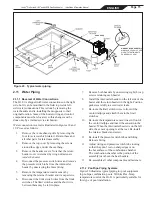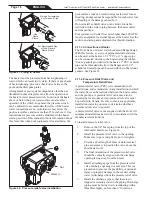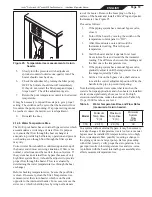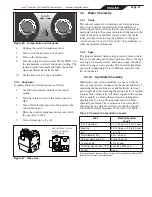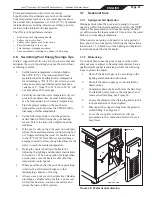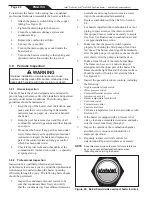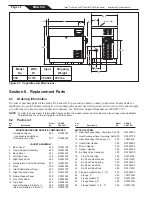
Page 29
ENGLISH
Jandy
®
Pro Series, Hi-E2
®
and Hi-E2R Gas-Fired Heater
|
Installation & Operation Manual
4.5.2.11 Combustion Blower
The combustion blower operates when it is provided with
115V, 60 Hz power. Confirm this by connecting the voltmeter
between the “neutral” wirenut and point C, which is the
terminal marked F2 on the ignition control. Unless the system
is in lockout, 115V should be present at point C whenever a
call for heat reaches the venturi pressure switch (i.e. 24V at
point 6). To be sure that a lockout condition is not in effect,
turn the heater off and then back on at the control.
If 24V is present at point 6 but 115V does not appear at
point C (and there is no lockout) the ignition control is
defective. If 115V power is available at point C and the
combustion blower does not run, the blower is defective
and should be replaced. Note, however, that the blower
has an internal overtemperature limit and before replacing
it confirm that the environment of the heater is not
excessively hot. If so, ventilation of the heater room may
be necessary.
4.5.2.12 Igniter
The igniter should glow during ignition attempts as outlined
in the earlier section on ignition control. If it does not,
connect the voltmeter between terminals marked D and E
on the ignition control. If 115V is present during the igniter-
on portion of the ignition sequence but there is no glow,
the igniter is probably defective. If voltage is not found, the
ignition control is defective and should be replaced.
An igniter which will not glow should be checked by
disconnecting the wires from the ignition control and
measuring the igniter resistance. A cold igniter should
have resistance in the range of 40 to 75 ohms. Replace the
igniter if resistance is outside of this range.
4.6 Venturi Combustion Flow System
Verifying proper operation of the comustion flow system
has two (2) aspects - air flow and gas flow. Air flow
is checked by measuring pressures at service ports on
the venturi. Gas flow is checked by evaluating venturi
pressures plus the regulator offset pressure and the gas
orifice size.
In a venturi flow system the difference between various
pressures is far more important than their “gauge” value
relative to the room. The
gas pressure offset and the
gas orifice pressure differential
are especially important
concepts. The following sections illustrate these and
related information.
To trouble shoot the ignition control, connect the voltmeter
probe at point 8 and set the control to call for heat. Observe
that the normal sequence takes place by noting blower
operation, the glow of the igniter through the combustion
chamber sight glass and then voltage at point 8. If the
blower does not operate or the igniter doesn’t glow,
investigate as outlined in a later sections. If both of these
components operate normally but voltage doesn’t appear
at point 8 during the trial for ignition, replace the ignition
control. If voltage appears at point 8 but there is no
ignition, proceed to analysis of other components.
4.5.2.9 Burner Limit Switch
The burner limit switch is located on the front surface of
the burner plenum near the top of the heater. Servicing this
switch normally requires removal of the top of the heater,
but it can be checked by probing for voltage at point 9 on
the vent limit switch. Point 9 is the terminal of the vent
limit switch to which is connected a brown wire coming
down from above. The vent limit switch is mounted on the
vent outlet diffuser above the combustion blower.
Voltage will be present at point 9 only during normal
operation or during a trial for ignition. If necessary
restart the heater using the control to obtain one of these
conditions. If voltage does not appear at point 9, the
burner limit switch is open. This may be due to burner
mis-adjustment, incorrect gas orifice size or similar
problems which should be investigated as outlined in
later sections. If there are no such problems and there is
no evidence of excessive burner temperature, replace the
burner limit switch.
4.5.2.10 Vent Limit Switch
Probe for voltage at point 10, which is the gas valve
terminal having a brown wire connected to it. As in the
preceding case, this terminal will have voltage present
only during a trial for ignition or during normal operation.
If voltage is not found, the vent limit switch is open,
indicating that the exhaust temperature has been too high.
Normal vent temperature is between 100oF and 140oF.
Excessive temperature might be due to excessive water
temperature or overfiring of the system. Investigate
water temperature and possible water flow deficiency.
Confirm that the heater is equipped for the correct fuel
gas - especially that propane gas is not being provided to a
heater configured for natural gas. To confirm correction of
the problem, re-set the switch by pushing the red button. If
vent temperature is normal and the switch will not allow
operation, replace it.
WARNING
The combustion blower, the igniter and some terminals
of the ignition control utilize 115V power and require
appropriate servicing precautions. Note that wires and
terminals of these components may be “hot” even
when the component is not operating.
Содержание HI-E2
Страница 2: ......
Страница 37: ...Page 37 ENGLISH Jandy Pro Series Hi E2 and Hi E2R Gas Fired Heater Installation Operation Manual NOTES...
Страница 38: ...Page 38 ENGLISH Jandy Pro Series Hi E2 and Hi E2R Gas Fired Heater Installation Operation Manual NOTES...
Страница 39: ...Page 39 ENGLISH Jandy Pro Series Hi E2 and Hi E2R Gas Fired Heater Installation Operation Manual NOTES...

